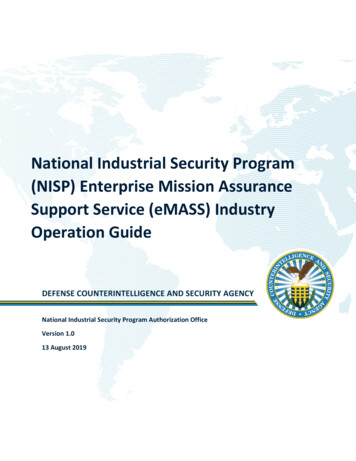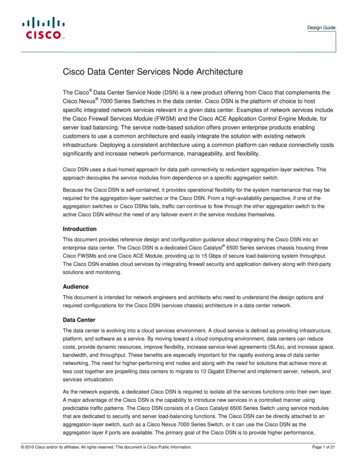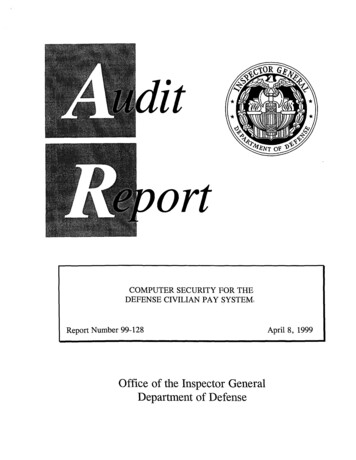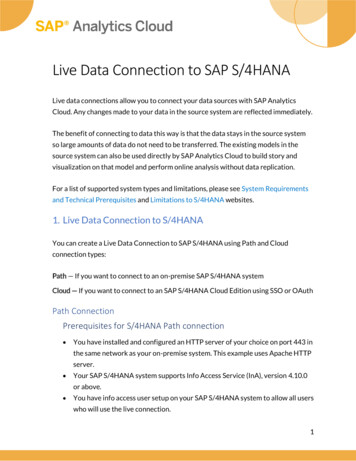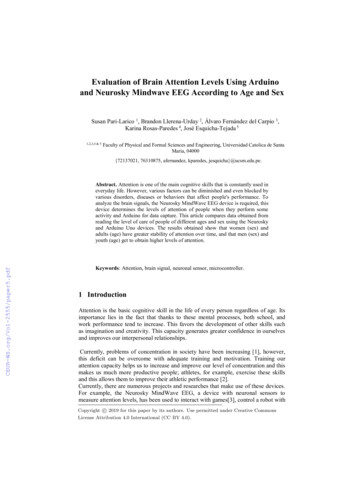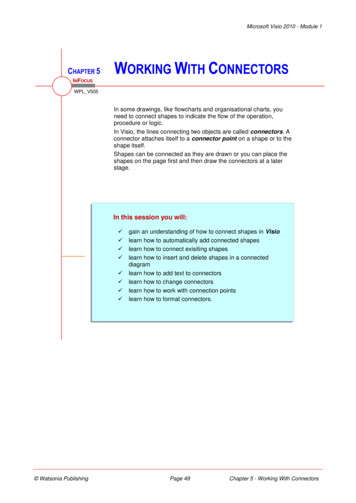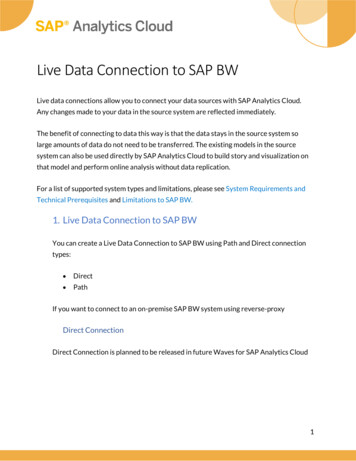
Transcription
DEFENSE INFORMATION SYSTEMS AGENCYDSN CONNECTION GUIDEVERSION May 23, 2005DRAFT
Defense Switched Network (DSN) Connection GuideTABLE OF CONTENTS1INTRODUCTION.11.11.2PURPOSE . 1AUDIENCE . 12OVERVIEW.23DSN VOICE EQUIPMENT REQUIREMENTS.43.13.24DSN VOICE EQUIPMENT COMPLIANCE LEVEL CATEGORIES. 4WHAT TO DO . 5ACTIONS FOR CATEGORY A (NO APL & NO ATO) .64.14.25CATEGORY A STEPS FOR COMPLIANCE. 6TEMPLATE FOR SSAA. 7ACTIONS FOR CATEGORY B (APL & NO ATO) .85.16CATEGORY B STEPS FOR COMPLIANCE. 8ACTIONS FOR CATEGORY C (NO APL, WITH ATO) .106.17CATEGORY C STEPS FOR COMPLIANCE. 10ACTIONS FOR CATEGORY D (APL AND ATO).127.1CATEGORY D STEPS FOR COMPLIANCE. 12APPENDIX A: DEFINITIONS AND ACRONYMS .14APPENDIX B: CONNECTION TEAM ELEMENTS .19APPENDIX C: FUTURE MODEL OF DSN ATC REQUEST PROCESS.22APPENDIX D: REFERENCES.24iiVERSION May 23, 2005
Defense Switched Network (DSN) Connection Guide1 INTRODUCTIONIn the past, DSN voice equipment was purchased according to the needs and the selection of theindividual Services. Security was enforced by the individual Services at a local level.While data systems have always been required to perform security testing on their systems, thevoice world has not. However, in a world of terrorists, hackers and high-level technology, theDSN faces greater risks than it did in simpler times. For this reason, policy DoDI 8100.3, DoDVoice Networks, 16 January 2004, requires DoD voice networks to be interoperable and securitycertified and accredited.Each of us impacts the safety of our country’s assets which could be compromised by a securitybreach. In the case of the DSN, we are not protecting just hardware and software, we areprotecting peoples’ lives, and supporting counterterrorism and the prevention of war. You needto understand that securing the DSN is not just a lot of unnecessary paperwork. The threats arevery real, and we need to establish a low-risk DSN, with the key focus being on the DSN voiceequipment.1.1PURPOSEThis Connection Guidance document was developed to provide helpful and detailed guidance tothe DoD components for certification and accreditation of voice equipment connected to theDSN. The sections are structured to provide the reader with a ‘how-to’ approach to theseprocesses. The purpose of this guide is to allow sites to evaluate their DSN voice equipment todetermine if they have an Authority To Operate (ATO) ‘Low Risk’ or not ‘High Risk’, and tofollow the enclosed procedures for each. This document discusses how certification andaccreditation testing is done, identifies procedures that DoD components can use to come intocompliance with interoperability and information assurance requirements, and defines the riskanalysis process for your DSN voice equipment.You do not need to read this entire document, only the sections that address thestatus of your DSN voice equipment.1.2AUDIENCEThis document is directed to the personnel of each DoD base/post/camp/station. It is aninformal, information guidance document meant to direct and enable people at the site level toproperly protect their DSN voice equipment.1VERSION May 23, 2005
Defense Switched Network (DSN) Connection Guide2 OVERVIEWThere are three basic requirements for DSN voice equipment: (1) DSN voice equipment that ispurchased must be on the Approved Products List, (2) it must be site-accredited via an ATO, and(3) it must receive Authority to Connect (ATC) from the DSN Single System Manager (SSM).There are a number of different elements involved in each of the individual processes associatedwith these three requirements. The following three are the main DISA elements involved thatanyone attempting to fulfill the requirements for connection to the DSN will need to be familiarwith.Voice Connection Approval Office (VCAO)The VCAO is the starting point for any of the three basic requirements for DSN voice equipmentbecause it is the focal point for the following DSN management activities.JITC interoperability (IO) and information assurance (IA) test requests, requirements,scheduling, and Approved Products List (APL) management for the DSN.DSN ATC request processing, approval, and notification.Local site Defense Information Technology Security Certification and AccreditationProcess (DITSCAP) assistance and monitoring agent for the DSN.The VCAO manages both the APL maintained on the JITC homepage, as well as the JITC testsubmittal request form maintained on the DSN homepage. The VCAO is also responsible fordevelopment and maintenance of the Authority to Connect request form, which is alsomaintained on the DSN homepage.A small section of the VCAO specializes in DITSCAP as well and is responsible for providingassistance and monitoring the completion status of the local DITSCAP for all bases, camps,posts, and stations that have DSN voice equipment. The VCAO is a good starting point forguidance on completing the local DITSCAP for DSN voice equipment. (Please refer toAppendix B for further information about the VCAO.)Joint Interoperability Certification (JIC) Test TeamThe JIC Test Team consists of members of the engineering staff located at JITC, Ft. Huachuca,Arizona. Once the JIC Action Officer (AO) receives a VCAO Test Submittal Form with aVCAO Tracking Number assigned, the proposed solution(s) are analyzed against the DoD VoiceNetworks Generic Switching Center Requirements (GSCR) for technical requirements. The JICAO is responsible for contacting the DoD sponsor of the proposed test for implementationrequirements, and maintaining contact with the sponsor throughout the testing process forupdates and changes. The JIC AO is also responsible for contacting the vendor for technicaldocumentation, Letters of Compliance, and to discuss funding requirements. The JITC AO is thePOC for coordination with the vendor for all equipment delivery and setup at the Joint2VERSION May 23, 2005
Defense Switched Network (DSN) Connection GuideInteroperability Test Command, Ft. Huachuca, AZ. (Please refer to Appendix B for furtherinformation about the JIC Test Team.)Information Assurance Test Team (IATT)The Information Assurance Test Team consists of members of the DISA Global InformationGrid (GIG) Enterprise Services (GES) engineering staff and Air Force Information WarfareCenter (AFIWC). The majority of all Information Assurance testing is conducted at the JITC, Ft.Huachuca, Arizona. An additional smaller portion is conducted in San Antonio, Texas atAFIWC. Once the IATT AO receives a VCAO Test Submittal Form with a VCAO TrackingNumber assigned, the proposed solution(s) are analyzed against the Information Assurance TestPlan (IATP) for technical requirements. The IATT AO is responsible for contacting the DoDsponsor of the proposed test for implementation requirements, and maintaining contact with thesponsor throughout the testing process for updates and changes. The IATT AO is alsoresponsible for contacting both the vendor and sponsor for technical documentation. The IATTwill contact both the vendor and sponsor of a solution to coordinate an Inbrief to discuss in theIA process, the solution, the testing scope, and test scheduling in detail prior to testing a solution.Upon completion of testing the IATT will coordinate with the vendor and sponsor of a product tohold an Outbrief to discuss in detail the results of the IA testing. (Please refer to Appendix B forfurther information about the JIC Test Team.)3VERSION May 23, 2005
Defense Switched Network (DSN) Connection Guide3 DSN VOICE EQUIPMENT REQUIREMENTSThere are three basic requirements for DSN voice equipment: (1) DSN voice equipment must bepurchased from the APL, (2) it must be site-accredited via an ATO, and (3) it must receive ATCfrom the DSN SSM. While all existing DSN voice equipment will be upgraded or replaced overa period of time, it is mandatory that a DITSCAP be performed on existing DSN voiceequipment at DSN locations. Site accreditation consists of a completed System SecurityAuthorization Agreement (SSAA) and an ATO letter signed by the Designated ApprovingAuthority (DAA).3.1DSN VOICE EQUIPMENT COMPLIANCE LEVEL CATEGORIESIn this document, DSN voice equipment is categorized into four main groups based on theircompliance levels. Two of these compliance levels result in conditions of ‘High-Risk’conditions for DSN voice equipment. The other two compliance levels result in either ‘MediumRisk’ or ‘Low-Risk’ conditions for DSN voice equipment.CategoryDescriptionIs EquipmentListed onAPL WebsiteSite levelATORisk levelANO APL & NO ATONONOHIGHBAPL & NO ATOYESNOHIGHCNO APL, WITH ATONOYESMEDIUMDAPL & ATOYESYESLOWThe following definitions and explanations are items listed in this document, and elaborate onthe items in the matrix above. Most of the existing DSN voice equipment will fall within eitherCategory A or B below.Category A: NO APL & NO ATO – In this category, DSN voice equipment neither appears onthe DSN Approved Products List (APL) nor has received a formal ATO document (i.e., a signedDAA letter). The main focus of this section will be to show the owners of DSN voice equipmentthat are not on the APL what to do. This category is considered to be ‘High-Risk’.Category B: APL & NO ATO – It is important that the site properly accredits all DSN voiceequipment. In this category, DSN voice equipment is included in the APL, but has not receiveda site accreditation or an ATO. Until the DSN voice equipment has an ATO, it is still consideredto be ‘High-Risk’.4VERSION May 23, 2005
Defense Switched Network (DSN) Connection GuideCategory C: NO APL, WITH ATO – As mentioned above, most DSN voice equipment waspurchased prior to the creation of the APL website. In this case, your DSN voice equipmentdoes not appear on the APL, but you have a site ATO for DSN. In this situation, your DSNvoice equipment is considered to be ‘Medium-Risk’.Category D: APL & ATO – DSN voice equipment in this category is relatively newequipment. It has been properly accredited by the local DAA for an ATO. Review our sectionin this document to confirm that nothing was missed during the accreditation process, and thatyou have applied for an ATC from the VCAO.But I still don’t knowwhat to do!3.2WHAT TO DO3.2.1 DSN Voice Equipment Compliance EvaluationEvaluate your DSN voice equipment and determine which category from the previous sectionbest describes the risk level of your equipment, thereby identifying the actions you need to taketo bring your DSN voice equipment to the ‘Low Risk’ level.3.2.2 Check the APL WebsiteCheck the APL on the web located at http://jitc.fhu.disa.mil/tssi/apl.html. It is a requirementof DoDI 8100.3 that new DSN voice equipment must be purchased from the APL. All items onthe APL are required to have been certified and accredited for IO and IA.If you do not have a signed approval letter from your site DAA (i.e., no ATO)the DSN voice equipment is considered ‘High Risk’.5VERSION May 23, 2005
Defense Switched Network (DSN) Connection Guide4 ACTIONS FOR CATEGORY A (NO APL & NO ATO)Although Category A configurations are considered to be ‘High Risk’, it may be possible tomake your DSN voice equipment ‘Low Risk’ by performing the actions listed in section 4.1.4.1CATEGORY A STEPS FOR COMPLIANCECategory A includes those systems that are NOT on the APL list, and have not received an ATO.For systems in this category, all of the steps listed below in sections 4.1.1, 4.1.2, and 4.1.3 shallbe completed.4.1.1 APL Product Submission – JIC and IA TestingVerify that the product is not already on the APL (seehttp://jitc.fhu.disa.mil/tssi/apl.html), or is not already scheduled for testing at JITC(see ify a Government sponsor for the product. (See Sponsorship topic inAppendix B, under the VCAO section.)Prepare a topology diagram of the system to be tested.Access http://www.disa.mil/gs/dsn/jic/index.html to fill out the on-line submittalform.The VCAO will contact you regarding the test dates and the outcome of the testing.4.1.2Local DITSCAP ATO ProceduresOnce the product is on the APL list as IO certified and IA accredited, follow thenext steps for authority to connect.Have your ISSO/IAO perform a compliance validation using the appropriate STIGsand STIG checklists. A copy may be obtained from the Field Security Office (FSO)Help Desk at mailto:fso spt@ritchie.disa.mil.6VERSION May 23, 2005
Defense Switched Network (DSN) Connection GuideHave your ISSO/IAO confirm that the hardware/software has the sameconfiguration as indicated in the interoperability certification letter. A copy may beobtained from http://jitc.fhu.disa.mil/tssi/apl.html.Have your ISSO/IAO read the DSN voice equipment IA test reports to ensure thatall vulnerabilities have been mitigated per installation. A copy may be obtained byemail from the VCAO at NS534-web@ncr.disa.mil.Ensure that your local SSAA has been updated to include all aspects of your specificDSN configuration.Ensure that an Authority to Operate memo has been written, and signed by thelocal DAA, for the specific DSN configuration.4.1.3Authority to ConnectRequest an ATC from the DSN SSM by completing the On-Line ATC submittalform at The VCAO will validate the submission, and request additional information, ifrequired.Once the request has been successfully validated, the DSN SSM will issue an interimauthority to connect (IATC)/ATC dependent on the certification and accreditationstatus of the DSN voice equipment. (Note: An ATC is good for 3 years, while anIATC timeframe may vary. A copy of the IATC/ATC memo, signed by the localDAA for the DSN voice equipment, is required for an IATC/ATC.)The DSN VCAO may be contacted at email: NS534-web@ncr.disa.mil.4.2TEMPLATE FOR SSAAA DITSCAP SSAA template has been created for unclassified voice networks and is available onthe DSN website (http://www.disa.mil/gs/dsn/index.html). Note that the Appendices must alsobe attached with the proper information and that a DAA letter is an attachment to the SSAA.The IASE site (located at http://iase.disa.mil/ditscap) provides additional information regardingDITSCAP.Some DoD Components have an SSAA for each base/post/camp/station, whileothers have an SSAA for each command. The acquiring activity is required tosubmit an Accreditation Letter from the Component DAA to the VCAO in orderto be approved for an ATC. The Accreditation Letter, generally an attachmentto the SSAA, is a statement from the DAA that the system is operating at anacceptable level of risk. (see DoDI html/520040.htm)7VERSION May 23, 2005
Defense Switched Network (DSN) Connection Guide5 ACTIONS FOR CATEGORY B (APL & NO ATO)Although Category B configurations are considered to be ‘High Risk’, it may be possible tomake your DSN voice equipment ‘Low Risk’ by performing the actions listed in section 5.1.5.1CATEGORY B STEPS FOR COMPLIANCECategory B includes those systems that are on the APL list, and have not received an ATO.Even if the product is on the APL, you must perform the following tasks in bold print for ATOand ATC before you can install it. (If the product is on the APL, the steps in section 5.1.1, innon-bold type may be omitted for solutions in this category.)5.1.1 APL Product Submission – JIC and IA Testing Verify that the product is not already on the APL (seehttp://jitc.fhu.disa.mil/tssi/apl.html), or is not already scheduled for testing at JITC (seehttp://jitc.fhu.disa.mil/tssi/schedule.html). Identify a Government sponsor for the product. (See Sponsorship topic in Appendix B,under the VCAO section.) Prepare a topology diagram of the system to be tested. Access www.disa.mil/gs/dsn/jic/index.html to fill out the online submittal form. The VCAO will contact you regarding the test dates and the outcome of the testing.5.1.2Local DITSCAP ATO ProceduresOnce the product is on the APL list as IO certified and IA accredited, follow thenext steps for authority to connect.Have your ISSO/IAO perform a compliance validation using the appropriate STIGsand STIG checklists. A copy may be obtained from the FSO Help Desk atmailto:fso spt@ritchie.disa.mil.Have your ISSO/IAO confirm that the hardware/software has the sameconfiguration as indicated in the interoperability certification letter. A copy may beobtained from http://jitc.fhu.disa.mil/tssi/apl.html.Have your ISSO/IAO read the DSN voice equipment IA test reports to ensure thatall vulnerabilities have been mitigated per installation. A copy may be obtained byemail from the VCAO at mailto:NS534-web@ncr.disa.mil.8VERSION May 23, 2005
Defense Switched Network (DSN) Connection GuideEnsure that your local SSAA has been updated to include all aspects of your specificDSN configuration.Ensure that an Authority to Operate memo has been written, and signed by thelocal DAA, for the specific DSN configuration.5.1.3Authority to Connect StepsRequest an ATC from the DSN SSM by completing the Online ATC submittal format The VCAO will validate the submission, and request additional information, ifrequired.Once the request has been successfully validated, the DSN SSM will issue anIATC/ATC dependent on the certification and accreditation status of the DSN voiceequipment. (Note: An ATC is good for 3 years, while an IATC timeframe may vary.A copy of the IATC/ATC memo, signed by the local DAA for the DSN voiceequipment, is required for an IATC/ATC.)The DSN VCAO may be contacted at email: NS534-web@ncr.disa.mil.An IATC is issued to sites that have requested to connect to the DSN, but havenot met all of the necessary requirements for receiving an ATC. The length oftime for which an IATC is issued is based on the local DITSCAP status of thesite requesting connection of their voice equipment to the DSN. If the voiceequipment being submitted for connection is not on the APL and does not havean ICTO, an IATC will not be granted.9VERSION May 23, 2005
Defense Switched Network (DSN) Connection Guide6 ACTIONS FOR CATEGORY C (NO APL, WITH ATO)6.1CATEGORY C STEPS FOR COMPLIANCECategory C includes those systems that are NOT on the APL list, but have received an ATO. Forsystems in this category, all of the steps listed below in this section in bold print shall becompleted. (The steps in section 6.1.2, indicated with the ‘ ’ symbol in non-bold type, may beomitted for solutions in this category.)6.1.1 APL Product Submission – JIC and IA TestingVerify that the product is not already on the APL (seehttp://jitc.fhu.disa.mil/tssi/apl.html), or is not already scheduled for testing at JITC(see ify a Government sponsor for the product. (See the Sponsorship topic inAppendix B, under the VCAO section.)Prepare a topology diagram of the system to be tested.Access http://www.disa.mil/gs/dsn/jic/index.html to fill out the on-line submittalform.The VCAO will contact you regarding the test dates and the outcome of the testing.6.1.2 Local DITSCAP Steps for ATO Once the product is on the APL list as IO certified and IA accredited, follow the nextsteps for authority to connect. Have your ISSO/IAO perform a compliance validation using the appropriate STIGs andSTIG checklists. A copy may be obtained from the Field Security Office (FSO) HelpDesk at mailto:fso spt@ritchie.disa.mil. Have your ISSO/IAO confirm that the hardware/software has the same configuration asindicated in the interoperability certification letter. A copy may be obtained fromhttp://jitc.fhu.disa.mil/tssi/apl.html. Have your ISSO/IAO read the DSN voice equipment IA test reports to ensure that allvulnerabilities have been mitigated per installation. A copy may be obtained by emailfrom the VCAO at mailto:NS534-web@ncr.disa.mil. Ensure that your local SSAA has been updated to include all aspects of your specificDSN configuration. Ensure that an Authority to Operate memo has been written, and signed by the localDAA, for the specific DSN configuration.10VERSION May 23, 2005
Defense Switched Network (DSN) Connection Guide6.1.3Authority to Connect StepsRequest an ATC from the DSN SSM by completing the On-Line ATC submittalform at The VCAO will validate the submission, and request additional information, ifrequired.Once the request has been successfully validated, the DSN SSM will issue anIATC/ATC dependent on the certification and accreditation status of the DSN voiceequipment. (Note: An ATC is good for 3 years, while an IATC timeframe may vary.A copy of the IATC/ATC memo, signed by the local DAA for the DSN voiceequipment, is required for an IATC/ATC.)The DSN VCAO may be contacted at email: NS534-web@ncr.disa.mil.If the solution being requested for ATC is a PBX-2, owned by a component ofthe DoD, then a waiver from the Joint Staff to the requirement for MilitaryUnique Features (MUF), mandated by CJCSI 6215.01B must be requested andapproved prior to the site receiving an IATC/ATC. Contact the VCAO forfurther information regarding the requirement for MUF.11VERSION May 23, 2005
Defense Switched Network (DSN) Connection Guide7 ACTIONS FOR CATEGORY D (APL AND ATO)Category D includes DSN voice equipment that is listed on the APL, AND has received an ATO.They are considered to be ‘Low Risk’ because they:Were purchased from the APLHave been JIC and IA accreditedHave had DITSCAP performed on themHave been validated via STIGs7.1CATEGORY D STEPS FOR COMPLIANCECategory D includes those systems that are on the APL list, and have received an ATO. Forsystems in this category, only the steps listed below in section 6.1.3 in bold print must becompleted in order to obtain an ATC. (The steps in sections 7.1.1 and 7.1.2, indicated with the‘ ’ symbol and in non-bold type, may be omitted for solutions in this category.)7.1.1 APL Product Submission – JIC and IA Testing Verify that the product is not already on the APL (seehttp://jitc.fhu.disa.mil/tssi/apl.html), or is not already scheduled for testing at JITC (seehttp://jitc.fhu.disa.mil/tssi/schedule.html). Identify a Government sponsor for the product. (See the Sponsorship topic in AppendixB, under the VCAO section.) Prepare a topology diagram of the system to be tested. Access www.disa.mil/gs/dsn/jic/index.html to fill out the on-line submittal form. The VCAO will contact you regarding the test dates and the outcome of the testing.7.1.2 Local DITSCAP ATO Procedures Once the product is on the APL list as IO certified and IA accredited, follow the nextsteps for authority to connect.12VERSION May 23, 2005
Defense Switched Network (DSN) Connection Guide 7.1.3Have your ISSO/IAO perform a compliance validation using the appropriate STIGs andSTIG checklists. A copy may be obtained from the Field Security Office (FSO) HelpDesk at mailto:fso spt@ritchie.disa.mil.Have your ISSO/IAO confirm that the hardware/software has the same configuration asindicated in the interoperability certification letter. A copy may be obtained fromhttp://jitc.fhu.disa.mil/tssi/apl.html.Have your ISSO/IAO read the DSN voice equipment IA test reports to ensure that allvulnerabilities have been mitigated per installation. A copy may be obtained by emailfrom the VCAO at mailto:NS534-web@ncr.disa.mil.Ensure that your local SSAA has been updated to include all aspects of your specificDSN configuration.Ensure that an Authority to Operate memo has been written, and signed by the localDAA, for the specific DSN configuration.Authority to Connect StepsRequest an ATC from the DSN SSM by completing the On-Line ATC submittalform at The VCAO will validate the submission, and request additional information, ifrequired.Once the request has been successfully validated, the DSN SSM will issue anIATC/ATC dependent on the certification and accreditation status of the DSN voiceequipment. (Note: An ATC is good for 3 years, while an IATC timeframe may vary.A copy of the IATC/ATC memo, signed by the local DAA for the DSN voiceequipment, is required for an IATC/ATC.)The DSN VCAO may be contacted at email: NS534-web@ncr.disa.mil.The DoD component is required to update their existing SSAA to accuratelyreflect DSN hardware/software/firmware at their sites. (If there is no existingSSAA, the DoD component is required to create an SSAA in conjunction withthe DITSCAP process.) Open the following link for further information:www.disa.mil/gs/dsn/ia.html.13VERSION May 23, 2005
Defense Switched Network (DSN) Connection GuideAPPENDIX A: DEFINITIONS AND ACRONYMSAFIWC (Air Force Information Warfare Center).AO (Action Officer).APL (Approved Product List).ATC (Authority To Connect).ATO (Authority To Operate).CA (Certification Authority). The CA is the official who is responsible for performing thecomprehensive evaluation of the technical and non-technical security features of an IT systemand other safeguards, made in support of the accreditation process, to establish how well aparticular design and implementation meet specified security requirements. There is a DISNCA, responsible for all DISN services, to include the DSN network. Each DoD componentbase/post/camp/station, or equivalent, also has a CA who is responsible for networks on theirinstallation.CRADA (Cooperative Research and Development Agreement).DAA (Local Designated Approving Authority). The DAA is an official with the authority toformally assume the responsibility for operating a system or network at an acceptable level ofrisk. In the case of DISN, the authority is assigned to four individuals who are members ofDISA, DIA, NSA, and the Joint Staff. Each DoD component base/post/camp/station, orequivalent, also has a DAA. The DAA may be delegated in writing by a responsible seniorauthority. Usually, a DAA is a senior commissioned officer or senior government civilian (i.e.,GS-15 or above). DAAs must be both U.S. citizens and DoD employees. DAAs may not alsoserve as CAs for systems they accredit.DITSCAP (Defense Information Technology Security Certification and AccreditationProcess. The DITSCAP fundamentally establishes a standard procedure for security with regardto the DSN. Each base/post/camp/station is required to have a DAA, a CA, and an SSAA fortheir IT assets, which includes voice, video, and data. (Additionally, DISA is required to have aDAA [DISN currently has 4 DAAs], a CA, and a SSAA for the DSN Network.) The DoDI5200.40 provides the procedures for DITSCAP that base/post/camp/station are required tofollow. A site SSAA template exists and can be obtained via the DSN web site. DSN DITSCAPis moving toward an automated process shown in Appendix C.DSAWG (DISN Security Accreditation Working Group). The DSAWG, as requested,performs analysis on all GIG waiver and appeal requests to determine compliance with allappropriate DISN security policies. The DAWG develops recommendations on the acceptability14VERSION May 23, 2005
Defense Switched Network (DSN) Connection Guideof the waiver/appeal in meeting DISN security policy and whether any DISN security policywaiver should be granted. The DSAWG provides recommendations to DISA as a part of theassessment of the waiver/appeal and to the GIG Waiver Panel Chair.”1 The DSAWG acts as IAexpert staff. The DAWG provides input and recommendations to the DISN DAA flag panel.FID (Facility Identifier).FSO (Field Security Office).GES (GIG Enterprise Services).GIG (Global Information Grid).GSCR (Generic Switching Center Requirements). DSN GSCR shall specify technicalrequirements for a telecommunications switch and shall be used to support lease or procurement,and testing of DSN telecommunications switches. The GSCR shall identify the minimum switchrequirements and features applicable to the overall DoD community for respective networks.The GSCR shall also define and document interoperability requirements amongtelecommunications switches that are part of the DSN. The Chairman of the Joint Chiefs of Staffshall validate and ASD (NII)/DoD CIO shall approve DSN GSCR. The DSN Generic SwitchTest Plan (GSTP) shall be based on the requirements of the GSCR.GSTP (Generic Switching Test Plan). DSN GSTP shall specify interoperability test criteriafor DSN telecommunications switches connected or planned for connection to the DSN. TheGSTP/SSTP shall address interoperability requirements between new technologies and theexisting network, as well as the performance impact of these new technologies on MUF.IA (Information Assurance).IA C&A (Information Assuran
Defense Switched Network (DSN) Connection Guide Interoperability Test Command, Ft. Huachuca, AZ. (Please refer to App
